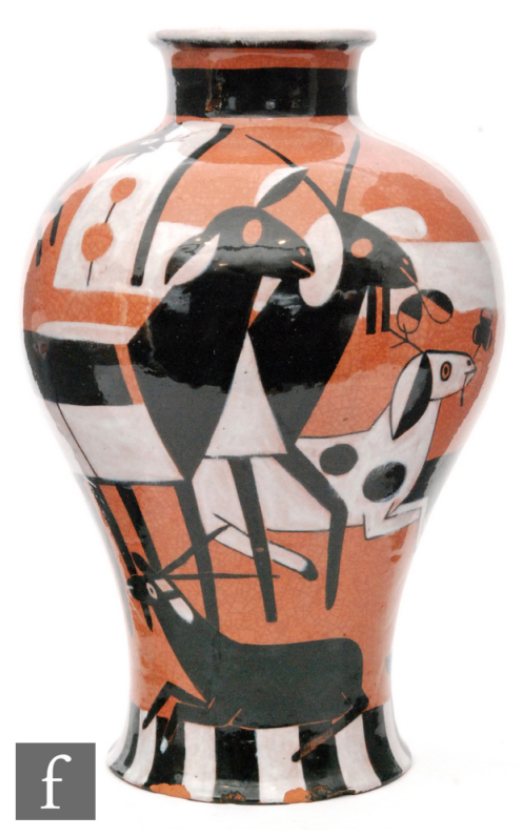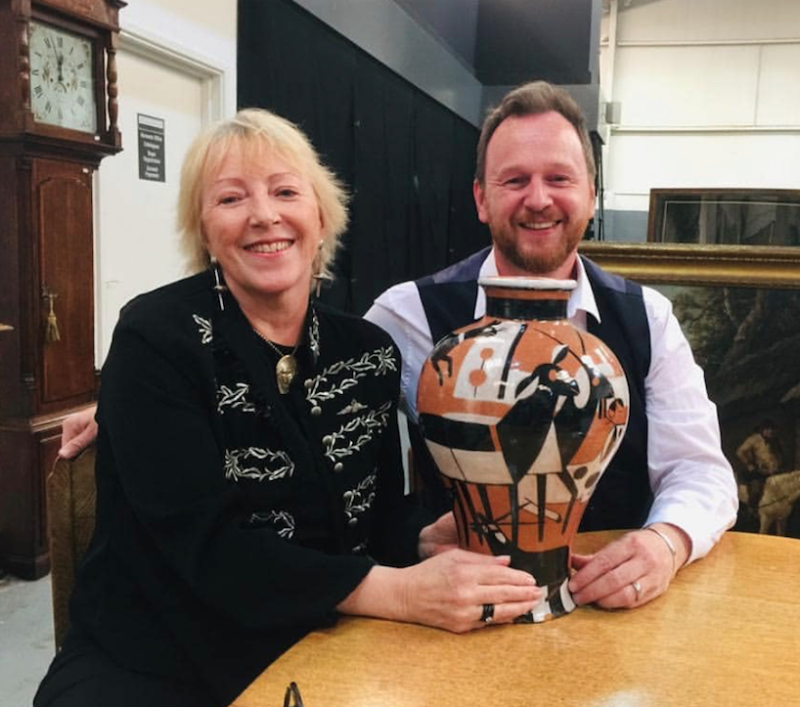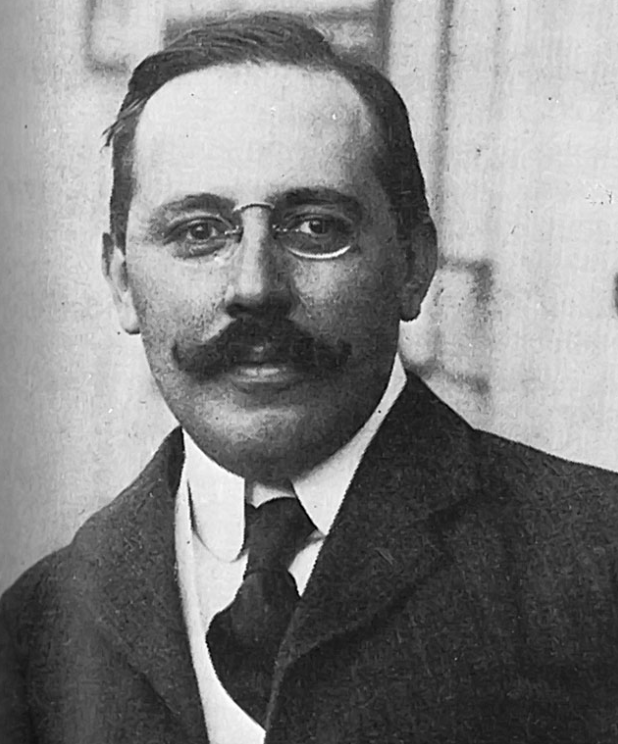Throw back Thursday - Josef Hoffmann and the Wiener Werkstätte
Over land and sea......Will Farmer tells of the story of a stunning Wiener Werkstätte vase by the great Josef Hoffmann which travelled from Vienna to South Africa and back to Stourbridge to be sold!
This story goes back many years when I was asked by Homes & Antiques magazine if I could answer a query that had come through from a lady in South Africa. As I opened up the images there before me on the screen was the most sensational piece of ceramic I had seen in a long time! The vase, a classic baluster form, was decorated in a simple three colour palette of just black, white and orange! The effect was bold, daring and just brilliant!
To the base of the vase were a series of impressed marks which indicated that the vase was from the great design powerhouse the Wiener Werkstätte! The Wiener Werkstätte was founded in 1903 by Koloman Moser and Josef Hoffmann, both of whom had been key members of the Vienna secession. The primary goal of the company was to bring good design and craft into all areas of life within the fields of ceramics, fashion, silver, furniture, and the graphic arts.
This met every aspect of their design ethos with its simple form but bold design, how on earth had it ended up in South Africa?
When I struck up a conversation with the owner I got to find out more of this vases unbelievable global journey. The owner was a keen collector and loved nothing more than spending her spare time going round the local antique markets and fairs in South Africa. On one particular day she had been mooching, as we all do in this wonderful business, and spotted the vase for sale on a stall. It was covered in green paint with small areas of the abstract animals showing through, there were a number of chips around the base of the vase and it looked a little sorry for itself, but for some reason the lady liked it and thought it would be perfect for her apartment.
On asking the price she was told the vase could be 250 South African Rand (approximately £10) and at that price she decided to buy it.
On getting it home the first thing she did was wash it, and this is where the story gets even more interesting. Under the warm water and with a little elbow grease the green paint covering the vase began to lift and fall away. Though at first worrying that she was damaging the vase this soon subsided as the decoration began to reveal itself! A strong burnt orange and wonderful abstract design in black and white began to appear across the whole of the vase, abstract animals and plants layed over each other, and then once the paint came away from the base, the marks impressed to the base! Once cleaned she could hardly believe what was before her, a piece transformed and looking a million times more than that green painted vase intended to use for flowers.
But who was it buy? Who designed it? Who made it? Well thats where I came in....
After seeing all the marks which included the Wiener Werkstätte interlaced W mark together with the style of the piece it was clear to me that while it didn't bear his personal mark there was only one designer who this could be attributed to....Josef Hoffmann! At the time I was delighted to advise the lady that despite the damage I felt her vase at auction could realise between £2000 and £3000, now thats a brilliant return on a £10 investment!
But who was Josef Hoffmann?
Here's a little more on one of my favourite designers and his huge body of work......
Josef Hoffmann – Pioneer of Modernism
Architect and designer Josef Hoffmann was a pioneer and standard bearer for design at the beginning of the 20th Century. Though considered to be part of the Art Nouveau movement his design aesthetic went far beyond the organic to incorporate a straighter more linear geometry to this most dramatic design movement.
His elegant designs and architectural statements were both at the time and looked back on today as great works that influenced the next generation of designers in the late 1920s and 1930s.
Josef Hoffmann was born in Moravia in what is now the Czech Republic, then a part of the Astro-Hungarian Empire. After attending the State School for Arts and Crafts in Brunn he went on the study under Otto Wagner at the Academy of Fine Arts in Vienna. After winning the Rome Prize and studying in Rome for a year, he returned to Vienna and worked in Wagner's studio from 1896.
Hoffmann embraced the Germanic form of Art Nouveau called Jugendstil. He broke away from traditionalism in favour of a new brand of historicism based upon functionalism and practicality married to an elegant aesthetic.
As a design aesthetic, he embraced the fundamental strength found in geometry and began to develop a new visual language which incorporated the use of strict geometric shapes applied in an elegant manner that created simple, often repetitive patterns.
He found similarly like-minded young designers and artists, and together in 1897, they initially formed the Vienna Secessionists. His colleagues were a group of highly talented individuals including Joseph Maria Olbrich, Kolomon Moser, and Gustav Klimt among others.
As a group, they rejected the prevailing conservatism that constricted the Viennese art world. They actively advocated for the inclusion of the New Art (Art Nouveau) as well as the work of foreign artists and designers to be shown in Vienna’s galleries. This led to Glasgow-based Charles Rennie Mackintosh exhibiting in Vienna as well as to influence and in turn be influenced by the members of Vienna Secession group.
Eventually, artistic differences led Hoffmann and several others to a break from the Secessionists to pursue another direction. In 1903, they set up the Wiener Werkstätte.
The Wiener Werkstätte emphasized the applied or decorative arts and the decoration was often elegantly restrained and thoughtfully, even sensitively geometric. Hoffmann placed an emphasis on quality and focused on goods for the home. Their goal was two-pronged: to elevate the role of the craftsman, and to give full worth to artistic inspiration. They wanted the decorative arts to be given the same value as the fine arts. The group developed workshops for the design and fabrication of a wide range of household elements, including utensils, flatware, furniture and even women’s house dresses. Their concern was for a total environment for living and embodied excellent craftsmanship and beauty.
Later, Hoffmann ultimately went on to become a major player in the world of the German Werkbund, another strategic design group. The work of its members led directly to the establishment and the aesthetic basis for the Bauhaus after WWI. This led to the Art Deco and Modernism movements that followed.
Despite a few honours and praise on Hoffmann’s 80th and 85th birthdays, he was virtually forgotten by the time of his death. And the several following generations of architects, designers and historians virtually ignored him.
Although he considered himself first and foremost an architect, it is his design legacy that is most often celebrated today. His formal inventiveness was endless. This is borne out by his artistic record. While the Hoffmann catalogue raisonné of his architectural documents approximately 500 commissions, by comparison the Austrian Museum of Applied Arts/Contemporary Art (MAK) alone has over 5,000 Hoffmann drawings in its collection. This disparity is a testament to his prolific inventiveness as a designer and the degree to which his outpouring in this area exceeded his as role an architect.
He designed both for mass-production and for handcrafted work. Some objects have remained in continuous production and others are extremely rare or unique. Although he was most prolific in the area of metalwork design, he also turned his attention to glass, furniture, textile and fashion design. His design ethic however meant that he considered everything he created a work of art. He brought a new level of elegance and simplicity to the domestic and built environment.
South Africa to Stourbridge......
Fast forward ten or more years and the vase every now and again would come back to mind however I believed that was the end of the story. A classic market find, well spotted and well bought....never did I think I would see it again!
Then last year an email came out of the blue with the classic 'do you remember me', followed by 'if you don't remember me you might remember my vase?'. There was the Hoffmann vase on my computer screen.
The owner was now ready to sell. After many years of enjoyment it was time to part company with the vase and she asked me if I would be happy to look after it? Planning a trip to the UK to visit family she informed me that she intended to bring the vase with her and could she arrange an appointment to meet me at Fieldings saleroom.
The vase was even better 'in the pot', bigger, more impressive and just wonderful!
After a little discussion and with a sense of slight reluctance to part with her best ever find we agreed a pre-sale auction estimate of £3000 to £5000, a step above my original valuation but on seeing the vase I thought well worth it.
In the run up to the sale there was a lot of interest in the vase and many enquiries from clients both here in the UK and also in Vienna! On opening the lot for sale the bidding started at £2700 and the internet didn't even get chance to press the button as a battle began and ended in the saleroom! Two determined bidders bounced the bidding steadily upwards in £100 increments to finally settle at a hammer price of £4500!
I won't deny, that was one of those lots I would have loved to have taken home, it was just sensational and now resides in a private collection here in the UK where it is loved and enjoyed everyday! The owner was thrilled with her result, from a £10 investment to a £4500 final hammer price.....now thats a brilliant return by anyones standards!
If nothing else, it just goes to prove that there are still sensational finds out there just waiting to be found! So while I appreciate we can't get out and visit the fairs and markets like we used too, one day we will once more!
Posted on 23 April 2020
Be in the know
Sign up for auction email alerts so you never miss another sale at Fieldings!
Register now



